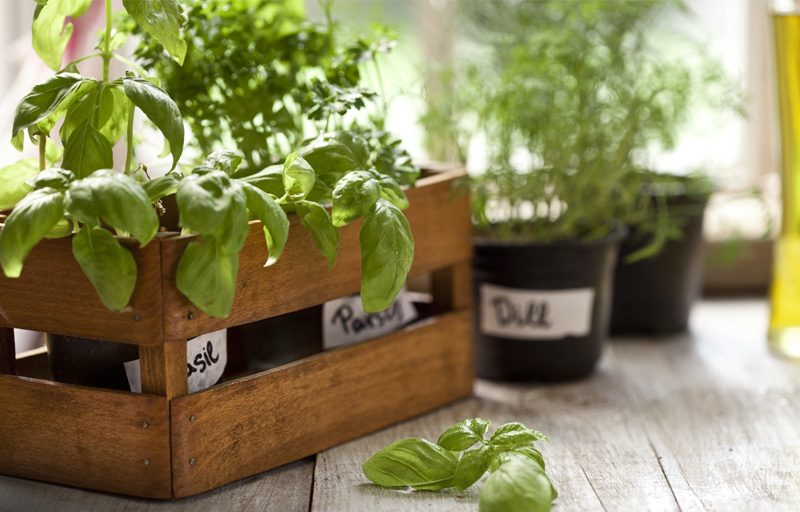Summer is upon us and for many people, that means creating lush gardens. But for those limited by space or time, having a giant vegetable patch may not be a realistic goal.
Container gardens used for vegetables and herbs not only offer you the opportunity to have some lovely plants on your patio, but they’re also practical because you can enjoy the (literal) fruits of your labor.
Before you get started on your container gardens, there are a few things you’ll want to consider in order to get best results.
Let’s start by taking a look at some questions you’ll need to answer before you get started on your container gardens.
#1. What’s Your Weather?
Sunlight — and the direction it shines onto your outdoor space — is the biggest thing you’ll need to be aware of. If your outdoor space faces south, it will receive direct sunlight all day long. This means that certain herbs or vegetables may or may not be suitable for the space.
Too much sun and your plants can quickly become burnt. Without the filter of a window, your plants can get really hot, especially if there are any reflective surfaces nearby.
The good news is that even if you don’t get a ton of sun, there are still lots of plants, like spinach or lettuce, that can grow really well with less than half a day’s worth of sun.
You’ll also need to think about wind. Some herbs and vegetables are more hardy than others, so wind may or may not be a concern for possible damage to your plants. If your space tends to be on the windy side, you’ll want to consider what kind of shelter you can offer your plants to protect them. A wire trellis or a piece of lattice can offer great coverage and also be functional for anything that climbs or needs to be staked, like tomatoes.
#2 Where’s Your Water Source?
If you want your container gardens to thrive, you’ll need to water them consistently (without overwatering them). If you have an outdoor hose, watering will likely be very simple.
However, if you don’t have a hose, think about how you’ll ensure your plants are well hydrated. Will that require 10 trips to the kitchen to fill up a watering can? Can you buy water stakes that only need to be filled once a week?
Plants in pots or containers need watering more regularly than those planted in the earth. Even though your container gardens will be outside, you can’t solely rely on Mother Nature for watering, so think about how you can make it as easy as possible.
#3. How Much Space Do You Have?
When taking on a new project like container gardens it can be really easy to get carried away because you’re excited. But your herbs and vegetables will need some room to grow, so you don’t want to overcrowd the space.
If your space is smaller, then it’s a good idea to start small. Starting with just a few pots will not only give you the time to focus on being successful with your gardening, but it also provides you the opportunity to figure out how much time and effort you really want to put into your container gardening.
As you become more experienced, you can then move on to vertical gardening if you’re looking for more options to make the most of a smaller space.
Plants, particularly vegetables, should be planted in the largest containers possible, so you’re better off having three or four large pots than nine or ten smaller ones which will be quickly outgrown.
#4. How Much Time Do You Have?
If you’re wondering how much time growing a bunch of plants can take, the answer is more time that you probably think. Even with container gardens, maintenance is important. Watering, fertilizing, and trimming all need to be done regularly.
If you’re someone who travels regularly for longer periods of time or tends to spend a lot of time away from your home, then you’ll need to consider how much time you actually want to spend on your container gardens and if you have someone who can help out when you’re not around.
#5. What’s Your Budget?
When starting your container gardens, you’ll have two choices: to buy herbs and vegetable plants that have already been started, or to start them yourself from seed.
Starting from seed is far less costly, but takes time as you’ll likely need to start your seeds indoors in the spring. Starting from established plants means spending more money, but the tradeoff may be worth it for you.
If you have friends who are already into gardening and grow their own herbs and veggies, consider asking them if they have any seeds or cuttings they’d be willing to share with you.
The most important thing to spend your money on is quality soil, as it’s the foundation for growing plants that will thrive.
You’ll also need to think about what sort of containers you want to use, but this doesn’t have to be expensive. If you want to go out and buy all new pots you absolutely can! However, if you’re trying to keep your spending low, you can use anything from old plastic pots to coffee cans. As long as your containers have holes in the bottom for proper drainage, anything goes.
General Tips for Growing Vegetables and Herbs
- Plastic pots retain more moisture, versus a terracotta or clay pot. If you’d rather stay away from plastic for aesthetic reasons, consider planting in the plastic pots and then placing it inside the clay pot.
- Hanging plant containers can be used for veggies such as strawberries, cherry tomatoes and herbs.
- Add gravel or perlite to the bottom of your pots to improve drainage.
- Fertilize your containers bi-weekly.
- Monitor your plants for insects. Bugs often love veggie plants, so if you notice something is eating at your plants you should be able to use Google to find out what the issue is and how to treat it.
Best Vegetables for Container Gardens
While there are lots of vegetables (and fruit) that can be grown in container gardens, there are some that are more suitable — especially for people new to trying their hand at it.
Some of the easiest vegetables to start with include:
- Romaine Lettuce
- Zucchini
- Cucumber
- Green beans
- Tomatoes
- Swiss Chard
- Peas
- Potatoes
- Peppers
Best Herbs for Container Gardens
Just about any herb can thrive in the right environment, so choosing which ones to put in your container gardens will really come down to preference.
Depending on how they grow (up versus out), you can often couple certain herbs together in the same container.
Your container garden herbs can include:
- Rosemary
- Basil
- Thyme
- Oregano
- Mint
- Parsley
Getting Started with Your Container Gardens
Now that you know how to create the best environment for your container gardens to thrive, consider what vegetables and herbs are the most appealing to you.
One of the biggest joys of garden containers is the harvest, so by choosing to grow food you can consume, you will be even more excited as things start to flourish. Before you know it, you’ll have a bountiful harvest, grown with your very own hands.
Westcott Homes offers modern living and smart design for today’s active families, in neighborhoods with room to grow. Our flexible floorplans, durable Pacific Northwest exteriors and luxurious interior details add up to a home you’ll delight in every day, and for years to come.







